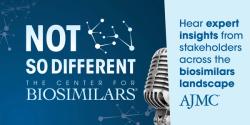© 2025 MJH Life Sciences™ and The Center for Biosimilars - Biosimilars, Health Economics & Insights. All rights reserved.
Contributor: What Is the Value of the Interchangeability Designation for a Biosimilar?
If every adalimumab biosimilar had an interchangeability designation, the United States could save additional $765 million annually, according to calculations from 3 biosimilar experts.
Biosimilars, to date, have achieved the promise of reducing prices and drug spending in the United States. The unquestioned safety and efficacy of biosimilars have given providers, patients, and employers, amongst many others, the confidence that savings will be even more robust as we embark on the primary target: the launch of Humira (adalimumab) biosimilars. Humira is by far the all-time biopharmaceutical revenue generator, with more than $15 billion in US sales in 2021.[1]
Adalimumab biosimilars will also be the first biosimilars introduced in the retail marketplace. To date, the majority of biosimilar competition has been for provider-administered medicines. Providers administer such drugs at their offices or infusion centers. As such, there is no need to worry about interchangeability designations since the prescriber and the medicine dispenser is the same health care professional. However, since adalimumab biosimilars may be dispensed directly to patients who self-administer the medicine by a pharmacist, the interchangeability policy for a biosimilar requires further examination. As in the past, when patients, providers, and employers were misinformed about the interchangeability designation by some brand biologic manufacturers. Today, certain biosimilar manufacturers are trying to downgrade the value of having a biosimilar designated by the FDA as interchangeable.
In 2019, a paper co-authored by several Pfizer colleagues discussed how the interchangeability policy was misused by various parties’ intent to create misinformation in the market. It is essential to review the conclusions.[2]
- All biosimilars are deemed safe and effective upon approval by the FDA.
- The Biologics Price Competition and Innovation Act of 2009 (BPCIA) created an abbreviated licensure pathway in the United States that allows for the development and approval of biologic products shown to be biosimilar to and/or interchangeable with a US FDA-licensed reference product.
- The interchangeability designation is intended to meet an additional statutory standard that would enable substitution at the pharmacy level without the intervention of the health care provider who prescribed the reference product.
- Without the interchangeability designation, pharmacy-level substitution may still occur but requires the additional administrative burden of a pharmacist contacting the prescriber, who must approve the substitution.
- A designation of interchangeability, or lack thereof, does not relate to the quality, safety, or effectiveness of biosimilars or interchangeable biosimilar products.
The paper did not investigate whether there is a value to having an interchangeability designation. With the exception of insulins and retinal drugs, to receive an interchangeability designation, biosimilars must go through additional switching studies and, in some cases, clinical trials mandated by the FDA.[3] Hence, the level of scrutiny is more than a typical biosimilar approved by the FDA.
Besides additional clinical or pharmacokinetic studies, it is crucial to quantify the economic value of having an interchangeability designation. We deciphered the savings associated with the designation by utilizing a surrogate marker. The surrogate marker we chose was the requirement of prior authorization. According to CoverMyMeds, patients abandon 37% of prescriptions requiring prior authorization.[4] The lack of designation may discourage substitution since a pharmacist has to seek approval from the prescriber. Our calculation is based on a study published by the Pacific Research Institute in 2021.[5]
According to the study, there were 5.8 million units of Humira sold in the United States, leading to approximately net spending of $10.3 billion. If 100% of Humira prescriptions were switched to a biosimilar, there is a potential for roughly $2 billion in savings. Since the lack of interchangeability designation may lead to abandonment, like prescribed medicine requiring prior authorization, only 63% of Humira prescriptions would be substituted, leading to $1.3 billion in savings. The differential of around $765 million is the economic value of having an interchangeability designation. All of the calculations are based on assumptions. However, for the first time, we can put a dollar amount on how an interchangeable adalimumab biosimilar may garner savings since such biosimilars will have a more straightforward path to substitution.
The BPCIA is a federal law facilitating a path toward approval of biosimilars with or without an interchangeability designation. Interchangeability designations allows a pharmacist to substitute a biosimilar at the point of dispensing without receiving authorization ahead of time from the prescribing health care professional. The requirement is codified in all state laws which govern pharmacist practice.
It is important to note that some manufacturers who continuously want to devalue the interchangeability designation were the ones who today support the adoption of the state requirement. Lack of interchangeability designations does not influence a biosimilar's safety or effectiveness. However, the lack of an interchangeability designation may create an environment where there may be reduced uptake of biosimilars.
For example, in Canada, the National Prescription Drug Utilization Information System has identified a lack of interchangeability as possibly reason for decreased uptake of biosimilars.[6] There is an intrinsic economic value that we have tried to quantify in this paper that requires closer scrutiny by patients, providers, employers, and state and federal government as we embark upon a vital milestone related to biosimilar uptake in the US marketplace: the introduction of Humira biosimilars.
Author Bios
Robert Popovian is a leader in health care and biopharmaceuticals who is accomplished in pharmaceutical science, business and government, with a distinctive array of academic and practical experience across a wide range of healthcare and business management functions. Positioned at the intersection of economics, policy, and innovation which maximizes patient access.
Winegarden is a senior fellow and director center for medical economics and innovation at Pacific Research Institute. He received his PhD in economics from George Mason University.
Peter Pitts is president and co-founder of the Center for Medicine in the Public Interest. He also serves as a visiting professor at the University of Paris School of Medicine. Pitts is a former member of the United States Senior Executive Service and Associate Commissioner of the US Food & Drug Administration where he served as senior communications and policy adviser to the Commissioner.
References
[1] AbbVie reports 22.7% growth in full-year 2021 net revenues. Pharmaceutical Technology. February 3, 2022. Accessed November 3, 2022. https://www.pharmaceutical-technology.com/news/abbvie-full-year-net-revenues/
[2] McKinley L, Kelton JM, Popovian R. Sowing confusion in the field: the interchangeable use of biosimilar terminology. Curr Med Res Opinon. 2019;35:4:619-621. doi: 10.1080/03007995.2018.1560223
[3] Considerations in demonstrating interchangeability with a reference product guidance for industry. FDA. May 2019. Accessed November 3, 2022. https://www.fda.gov/media/124907/download
[4] Prior authorization. CoverMyMeds. Accessed November 3, 2022. https://www.covermymeds.com/main/patient-journey/prior-authorization/
[5] Winegarden, W. Generating drug savings through competition—Estimating the potential savings from competition to Humira and Enbrel. November 2021. Accessed November 3, 2022. https://medecon.org/wp-content/uploads/2021/11/DrugSavings_Humira_Final.pdf
[6] Zhang Y; The National Prescription Drug Utilization Information System in Canada. Biosimilars in Canada: building momentum in the wake of recent switching policies presented at: 2021 CADTH Symposium; November 2-4, 2021; virtual. https://www.canada.ca/en/patented-medicine-prices-review/services/npduis/analytical-studies/slide-presentations/biosimilars-cadth-2021.html



